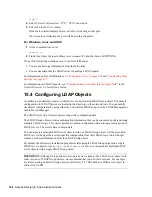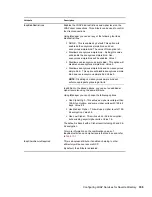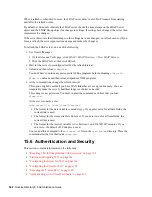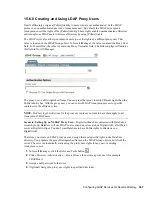
366
Novell eDirectory 8.8 Administration Guide
n
ov
do
cx (e
n)
22
Ju
n
e 20
09
To manually export the trusted root, see
Exporting a Trusted Root or Public Key Certificate (http://
www.novell.com/documentation/lg/crt27/crtadmin/data/a2ebopb.html#a2ebopd)
.
The Export functionality will create the specified file. Although you can modify the filename, it's a
good idea to leave “DNS” or “IP” in the filename, so that you can recognize the type of material
object. Also leave the servername.
Install the self-assigned CA in all browsers that establish secure LDAP connections to eDirectory.
If you are using the certificate with Microsoft products (for example, Internet Explorer), leave the
.der extension.
If applications or SDKs require the certificate, import it into a certificate database.
Internet Explorer 5 exports root certificates automatically with a registry update. The traditional
.X509 extension used by Microsoft is required.
15.6.6 Authenticating with a Client Certificate
Mutual Authentication requires a TLS session and a client certificate. Both the server and the client
must verify that they are the objects that they claim to be. The client certificate was validated at the
Transport layer. However, at the LDAP protocol layer, the client is anonymous until the client issues
an LDAP bind request.
Up to this point, the client has proven its authenticity to the server but not to LDAP. If a client wants
to authenticate as the identity contained in the client certificate, the client binds by using the SASL
EXTERNAL mechanism.
1
In Novell iManager, click the
Roles and Tasks
button
.
2
Click
LDAP
>
LDAP Overview
.
3
Click
View LDAP Servers
, then click the name of an LDAP server object.
4
Click
Connections
.
5
In the Transport Layer Security section, select the drop-down menu for
Client Certificate
, then
select
Required
.
This enables Mutual Authentication.
6
Click
Apply
, then click
OK
.
15.6.7 Using Certificate Authorities from Third-Party Providers
During the eDirectory installation, the LDAP server receives a tree Certificate Authority (CA). The
LDAP Key Material object is based on that CA. Any certificate that a client sends to the LDAP
server must be able to be validated through that tree CA.
LDAP Services for eDirectory 8.8 supports multiple certificate authorities. Novell's tree CA is just
one certificate authority. The LDAP server might have other CAs (for example, from VeriSign*, an
external company.) This additional CA is also a trusted root.
To configure the LDAP server to use multiple certificate authorities, set the
ldapTLSTrustedRootContainer attribute on the LDAP server object. By referencing multiple
certificate authorities, the LDAP server allows a client to use a certificate from an external authority.
Summary of Contents for EDIRECTORY 8.8 SP5
Page 4: ...4 Novell eDirectory 8 8 Administration Guide novdocx en 22 June 2009...
Page 72: ...72 Novell eDirectory 8 8 Administration Guide novdocx en 22 June 2009...
Page 118: ...118 Novell eDirectory 8 8 Administration Guide novdocx en 22 June 2009...
Page 130: ...130 Novell eDirectory 8 8 Administration Guide novdocx en 22 June 2009...
Page 188: ...188 Novell eDirectory 8 8 Administration Guide novdocx en 22 June 2009...
Page 222: ...222 Novell eDirectory 8 8 Administration Guide novdocx en 22 June 2009...
Page 240: ...240 Novell eDirectory 8 8 Administration Guide novdocx en 22 June 2009...
Page 264: ...264 Novell eDirectory 8 8 Administration Guide novdocx en 22 June 2009...
Page 290: ...290 Novell eDirectory 8 8 Administration Guide novdocx en 22 June 2009...
Page 322: ...322 Novell eDirectory 8 8 Administration Guide novdocx en 22 June 2009...
Page 540: ...540 Novell eDirectory 8 8 Administration Guide novdocx en 22 June 2009...
Page 548: ...548 Novell eDirectory 8 8 Administration Guide novdocx en 22 June 2009...
Page 616: ...616 Novell eDirectory 8 8 Administration Guide novdocx en 22 June 2009...
















































